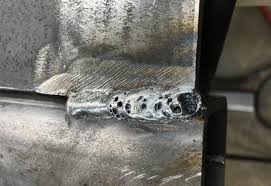What is Porosity in Welding: Understanding Its Reasons and Enhancing Your Abilities
What is Porosity in Welding: Understanding Its Reasons and Enhancing Your Abilities
Blog Article
Comprehending Porosity in Welding: Exploring Causes, Results, and Prevention Methods
Porosity in welding is a persistent difficulty that can significantly impact the top quality and honesty of welds. As experts in the welding market are cognizant, comprehending the reasons, results, and prevention methods associated with porosity is vital for achieving durable and dependable welds. By delving right into the source of porosity, analyzing its detrimental impacts on weld top quality, and discovering effective prevention techniques, welders can boost their expertise and abilities to generate top notch welds constantly. The detailed interplay of aspects adding to porosity needs a thorough understanding and a proactive approach to guarantee successful welding results.
Typical Sources Of Porosity
Contamination, in the type of dirt, grease, or rust on the welding surface, produces gas pockets when heated up, leading to porosity in the weld. Inappropriate protecting takes place when the shielding gas, frequently utilized in procedures like MIG and TIG welding, is incapable to fully safeguard the liquified weld swimming pool from responding with the surrounding air, resulting in gas entrapment and succeeding porosity. Furthermore, poor gas protection, often due to wrong circulation rates or nozzle positioning, can leave parts of the weld unprotected, allowing porosity to develop.
Effects on Weld Quality
The visibility of porosity in a weld can substantially compromise the overall quality and stability of the bonded joint. Porosity within a weld creates spaces or dental caries that weaken the framework, making it more at risk to splitting, rust, and mechanical failing. These gaps function as stress concentrators, lowering the load-bearing capacity of the weld and raising the probability of premature failure under applied tension. In addition, porosity can likewise function as potential websites for hydrogen entrapment, further aggravating the deterioration of the weld's mechanical properties.
Furthermore, porosity can impede the efficiency of non-destructive screening (NDT) strategies, making it testing to spot other issues or suspensions within the weld. This can cause significant safety issues, particularly in critical applications where the structural honesty of the bonded parts is vital.

Prevention Techniques Introduction
Provided the harmful impact of porosity on weld high quality, efficient prevention methods are critical to maintaining the structural honesty of welded joints. Furthermore, choosing the find out here now proper welding criteria, such as voltage, present, and travel rate, can aid lessen the danger of porosity formation. By incorporating these avoidance strategies right into welding techniques, the event of porosity can be dramatically decreased, leading to stronger and a lot more reliable bonded joints.
Value of Appropriate Protecting
Proper shielding in welding plays an important function in avoiding climatic contamination and ensuring the integrity of welded joints. Protecting gases, such as argon, helium, or a mixture of both, are typically utilized to protect the weld pool from responding with components airborne like oxygen and nitrogen. When these reactive elements come into call with the warm weld pool, they can trigger porosity, resulting in weak welds with reduced mechanical buildings.

Poor shielding can result in various problems like porosity, spatter, and oxidation, jeopardizing the structural honesty of the bonded joint. Therefore, sticking to correct securing techniques is necessary to produce top notch additional info welds with marginal issues and make certain the durability and reliability of the welded elements (What is Porosity).
Monitoring and Control Approaches
How can welders efficiently keep an eye on and regulate the welding procedure to guarantee optimal results and stop problems like porosity? By continually monitoring these variables, welders can recognize variances from the optimal problems and make instant modifications to prevent porosity formation.

Furthermore, carrying out appropriate training programs for welders is vital for checking and managing the welding procedure effectively. What is Porosity. Informing welders on the significance of keeping consistent criteria, such as proper gas securing and travel speed, can help stop porosity issues. Normal assessments and qualifications can also make certain that welders excel in monitoring and regulating welding procedures
Furthermore, the usage of automated welding systems can boost tracking and control capacities. These systems can exactly manage welding criteria, reducing the probability of human error and making certain constant weld top quality. By combining innovative surveillance technologies, training programs, and automated systems, welders can efficiently keep track of and control the welding process to minimize porosity flaws and achieve top notch welds.
Verdict

Report this page